Page 1
Daily News
By Gail Helmer
| Send Us News | Archives | Main |
Wednesday, January 29, 2003
- Free Month of European Warbirds
- New World Order Retail Patch v1.35
- Huge Hearts of Iron Patch
- New FPS: Line of Sight: Vietnam
- Sims Most Popular Retail Titles of 2002
- New KC-135R Stratotanker Add-on
- Strike Fighters Mods, Utils, and Repaints Source
- Raven Shield Competition Report
- USAF F-15 Eagle (freeware) for FS2002
- AVRO Arrow Archives: Images, Movies
- Flight Of The Simulator
- Navy Prepares to Navigate With Wireless LANs
- U.S. Army Special Operations Aircraft Get Enhanced Situational Awareness
- Boeing Demonstrates Advanced Technology on Super Hornet Platform
- C-130 Herc Flies 40 Years and 30,000 Hours
- 100 Years After Kitty Hawk: Re-creation of Wright's First Flight
- U.S. Navy Gets 167 New Tactical Tomahawks
PC Game & Hardware News
Free Month of European Warbirds
Tiscali Games, in cooperation with Warbirds developer iEN, will launch the European Warbirds service on February 1st, 2003.

European Warbirds giving away a free month.
The whole month of February will be a completely free promotional month, allowing unlimited play of Warbirds 2.77r3 EURO. The European Warbirds server is based in the heart of Europe at the internet hub of Frankfurt, Germany, providing all European online pilots with a fast connection. Also, pricing options for the subscription-based flying after the promotional month are quite different from the US Warbirds, making it an affordable experience for all Europeans.
Website: European Warbirds
New World Order Retail Patch v1.35
PR Info: New World Order is a team-based multiplayer game where teams battle out heavily in environments that could be taken right out of an action movie. It's a fast paced action simulator with attitude.
When you need a break from the Frag-feast multiplayer chaos start up a single mission or a co-op mission with some of your friends and go into the single player experience with mission based sneak, seek and destroy missions.
Choose the team that you feel is the best for you and eliminate the other. Defend high-tech labs, storm mansions or make a surprise attack at the warehouse on the docks and many more scenarios.
Choose the Global Assault Team (GAT) with it's excellent weapon options and tactical information or join the evil side with all it's bad attitude and home turf advantage.
Download: 3D Gamers
Huge Hearts of Iron Patch
PR Info: Hearts of Iron is the first ever World War II PC game of true Grand Strategic scope. The game map spans the entire world and allows players to take the War to any new front of their choosing. Any nation in the world is playable, but the game focuses on the epic struggle between the great alliances of the new world orders Fascism, Communism and Democracy.
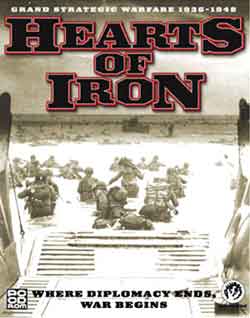
Hearts of Iron gets a major transplant
Hearts of Iron is developed by the team behind the awardwinning sales success Europa Universalis I and II and brings the same superdetail to a modern day gaming experience.
Hearts of Iron aims to be no less than the definitive World War II strategic experience.
A word on the patch from the support team:A warning. If you have modified any of the HOI files, the patch will not over-write your modified files. If this is the case, you should:All patches should be backward compatable (you don't need to start a fresh game), but it is nonetheless recommended to start a new game with each patch.
- Backup your modifications.
- Uninstall HOI.
- Install HOI.
- Apply the patch.
- Figure out what you want to do with your modifications.
Download: HOI-Patch-1.03... [5 MB]
New FPS: Line of Sight: Vietnam
From the folks who brought us Deadly Dozen comes a new FPS called Line of Sight: Vietnam. As we understand it, you'll be a sniper in the 'Nam. We tried to find some info about this new title from nFusion's own site, but came up empty. We found that 3DGamers has fourteen new screenshots which you can check out here.
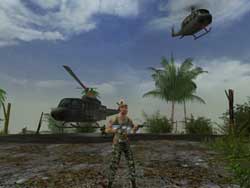
Yet another Vietnam FPS
Website: 3DGamers
Sims Most Popular Retail Titles of 2002
Looks like simulations are back in favor with the gaming public! (what's that you say? not that kind of sims? Oh! "The Sims". Riiiiiighhhht!). Yeah, I'm a little bugger for getting your hopes up.
Thankfully, there was one title in 2002 top ten that we simmers could enjoy and the was MOHAA. Here's the complete list from Gamespot:
Rank | Title | Publisher | Release Date | Average Price
1 | The Sims: Vacation | EA | Mar '02 | $28
2 | The Sims: Unleashed | EA | Sept '02 | $28
3 | Warcraft III: Reign of Chaos | Vivendi | June '02 | $54
4 | Medal of Honor: Allied Assault | EA | Jan '02 | $44
5 | The Sims | EA | Feb '00 | $42
6 | The Sims: Hot Date | EA | Nov '01 | $29
7 | The Sims Deluxe | EA | Sept '02 | $41
8 | Zoo Tycoon | Microsoft | Oct '01 | $27
9 | Harry Potter and the Sorcerer's Stone | EA | Nov '01 | $26
Source: Gamespot
New KC-135R Stratotanker Add-on
New from Abacus is a KC-135R Stratotanker.
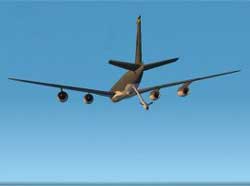
KC-135 Stratotanker by Ray Lopez for FS2002
From the Abacus website:When the military had the need for a tanker in the 1950's, it borrowed the basic design of the Boeing 707 for this purpose. Since the original model appeared, the KC-135R has been fitted with CFM-56 engines allowing it to cruise at 500 mph for up to 1500 miles as it serves as a mobile refueling base.
The Stratotanker was crafted by Rey Lopez and features the lastest technology that is now built into FS Design Studio V2.
This includes fully animated moving parts including 2D and 3D virtual dynamic cockpit, rolling wheels, sliding cockpit window, in-flight refueling arm and thrust reversers
This KC-135 is part of Abacus's Premier Collection and are available for you to test fly for up to seven days.
Website: Abacus
Strike Fighters Mods, Utils, and Repaints Source
Who'd of thunk it? AVSIM, a civilian aviation simulation mecca has all sorts of air combat sim stuff. Here what we just found in the Strike Fighters category of their vast file archives.
- SF Campaign Burning Sands II, by David Slavens
This is a Single Aircraft campaign for Strike Fighters. No more waiting to have to upgrade to get the next better plane.
- 32 TFS F-4E, by David Slavens
- Canadian Tactical Camouflage Starfighter, by Nathan Anderson
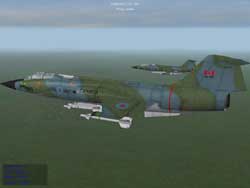
Strike Fighters Star Fighter with Canadian Camo
Web Page: AVSIM's Strike Fighters Mods, Utils & Patches
Web Page: AVSIM's Strike Fighters Repaints
Raven Shield Competition Report
The official Rainbow Six 3: Raven Shield website has posted another competition report. This week's report lists five clan ladders and the scores for the five top-ranked clans within each clan ladder. Of interest is the fact that some clans play in (and dominate) more than one ladder—either that's real dedication or they have way too much time on their hands! :)
Website: Official Raven Shield Site
USAF F-15 Eagle (freeware) for FS2002
FSPlanet.com has an USAF F-15 Eagle of the 555th TFTS "Triple Nickel", 58th TFTW Luke AFB Arizona. This was the first operational F-15 unit. Aircraft is in the 1975 air superiority blue scheme. High-vis markings with lights, contrail, smoke and afterburner effects. Gmax aircraft by Kimitaka Nishida, repaint by Paul Barry.
For this and about a bajillion other free aircraft repaints, mods, and the like, go to the sites listed below:
Website: FSPlanet.com
Website: FSFreeware.com
Defense and Aerospace News
AVRO Arrow Media Archives: Images, Movies
The Arrow Alliance clued us into a very cool web archive on the Canadian AVRO Arrow on the Canadian Broadcasting Corporation's website. Check it out!
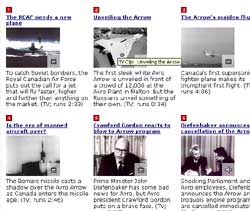
CBC's AVRO Arrow Media Archive. Very cool.
Website: CBC AVRO Arrow Media Archive
Website: Arrow Alliance
Flight Of The Simulator
MARINE CORPS AIR STATION IWAKUNI, Japan — Performing duty to perfection is what service members strive to achieve. The thought of something going wrong and that other people's lives and safety are at risk is always in the back of people's minds. Training is a very important part of achieving this goal of perfection.
Pilots here go through many hours of training to help ensure their safety and achieve mission accomplishment. Part of their training includes a monthly visit to the Tactical Operations Flight Trainer.
The TOFT is an exact replica of an F/A-18C Hornet cockpit, according to John McLaughlin, site manager for L-3 Communications Link Simulation and Training.
"The flight simulator is a training device used to optimize a pilot's capabilities in emergency situations and help them improve their weapons tactics," said McLaughlin. "Pilots aboard Iwakuni are required to use the simulator monthly to complete emergency procedure qualifications. Air crews coming to Iwakuni for the first time are required to do a local hop, first in the simulator and then in the actual aircraft."
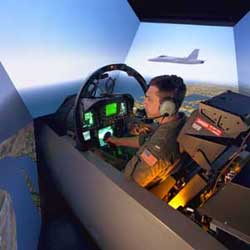
The Navy's F/A-18C TOFT simulator in action
The simulator is a good training tool, but it does have minor problems, noted Peter Kearney, lead technician.
"When it is working properly it is a great machine, but when something goes wrong it becomes a big problem," said Kearney. "The biggest problem we have is the availability of parts. It's hard to get parts because even the smallest ones need to be shipped from the States."
One of the biggest reasons for having the TOFT is cost efficiency. The simulator saves a great deal of money compared to flying an actual aircraft.
"It costs around $5,000 an hour for a flight in a Hornet, where as the simulator only costs a couple hundred dollars for each run," said Maj. Jeffery P. Staman, Marine Wing Support Squadron 171 executive officer. "It saves everyone a lot of money."
The simulator also saves a lot of time, noted Staman.
"One regular flight requires an average of 15 man hours," said Staman. "That is a lot of time and money when we can just come down here to complete our instrument qualifications. Time is money."
The simulator is a great way for pilots to practice their abilities, without risk and at minimal costs, noted Staman.
"The simulator is very important in training," said Staman. "It gives us the opportunity to prefect our essential skills and the discipline needed to fly an aircraft."
Training is very important in all aspects of the military, noted McLaughlin. Saving money, time and preventing accidents helps to make sure that everyone gets the most out of their training.
"Our main goal is to keep pilots safe," said McLaughlin, "You can replace hardware, but you cannot replace people."
Website: US Marines
Website: Naval Aviation Training Systems
Website: L3 Communications: Link Simulation and Training
Navy Prepares to Navigate With Wireless LANs
By John Cox, Network World
Wireless LANs are being installed on Navy warships to free up manpower, reduce crew sizes, and improve monitoring of a range of mechanical and electrical systems.
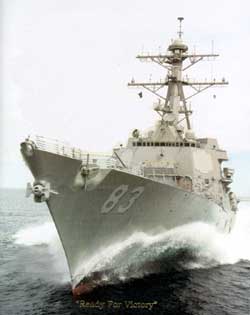
Warships will feature 802.11b wireless systems, allowing captains to command the entire ship from anywhere on board.
The installation effort, dubbed Total Ship Monitoring, lets Navy crew members check and control systems from computers anywhere on board. It's an extension of the Smartship refitting and redesign program the Navy launched in 1996 to let captains command their ships from anywhere on board.
The USS Howard, a guided-missile destroyer commissioned in 2001 and assigned to the Navy's 3rd Fleet, based in San Diego, is being outfitted with specialized wireless gateways based on the IEEE 802.11b wireless LAN standard. The gateways, which defense contractor 3E Technologies International (3ETI) designed and built, use a radio link to interconnect sensors on gear such as pumps and motors with back-end data processing applications.
So instead of laying hundreds of feet of cabling by cutting through a steel ship and adding weight to the vessel, the radio link makes possible much faster and less-disruptive deployment of the sensors.
Full Story: PC World
U.S. Army Special Operations Aircraft Get Enhanced Situational Awareness
ATLANTA — EMS Technologies, Inc. is announcing today that ITT Industries, Inc. has recently awarded EMS a contract valued at more than $2 million. EMS will equip seven U.S. Army special operations aircraft with advanced radar- jamming functions as part of the AN/ALQ-211 Suite of Integrated RF Countermeasures (SIRFC) system.
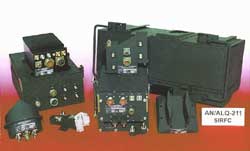
The AN/ALQ-211 SIRFC Suite of Components
The SIRFC system, developed by ITT Industries' Avionics Division, is a fully integrated aircraft self-protection suite. The system provides advanced situational awareness, sensor fusion, threat warning, and electronic countermeasures (ECM) capabilities necessary to evade or defeat modern air defense threats.
The AN/ALQ-211 system is planned for deployment on a number of U.S. Army and U.S. Air Force platforms, including the AH-64D Apache Longbow, Special Operations MH-60K and MH-47E, RAH-66 Comanche and the CV-22 Osprey.
This is the fourth contract to EMS for SIRFC-related efforts since July 2001. Prior contracts, totaling close to $10 million, were for non-recurring engineering and pre-production efforts. The latest contract is the first production order, and was awarded under a Memorandum of Understanding between the companies that defines the terms for delivery of the first 196 systems.
"In anticipation of the long-term requirements for this program, we have worked closely with ITT's SIRFC Team to achieve significant cost reductions and manufacturing efficiencies. We are very proud of this SIRFC production award as it validates ITT's and EMS's commitment to provide a cost effective system to the customer," stated Jay Grove, senior vice president and general manager - EMS Technologies' Space & Technology Group/Atlanta.
Web site: EMS
Boeing Demonstrates Advanced Technology on Super Hornet Platform
ST. LOUIS — Boeing has demonstrated a breakthrough in close air support capability by transmitting digital imagery with targeting information between warfighters on the ground and in the air.
The demonstration included an F/A-18F Super Hornet and a forward air controller communicating over existing radio links. The demonstration, which took place at Naval Air Station Fallon, Nev., is another example of the leading role Boeing has taken developing network-centric warfighting capabilities.
In the demonstration, a forward air controller, equipped with the advanced close air support system, or ACASS, provided rough target coordinates to the pilot of the F/A-18. The pilot used the Boeing Gateway to Airborne Tactical Data Exchange avionics system to capture a sensor image of the target, and transmit the image back to the controller for target confirmation. Newly developed ACASS software enabled the controller to view the image, annotate it with critical information and transmit it back to the pilot to complete the air strike. This information exchange ensures that both the warfighter on the ground and in the air share a common picture of the target.
"What this demonstration really boils down to is improved situational awareness; the timely, accurate exchange of information and greatly enhanced target identification," said Tony Parasida, vice president and general manager the Boeing F/A-18 program. "Today's warfighting environment requires up-to-the minute information that is seamlessly exchanged among a number of platforms, people and sites. This demonstration further reinforces the Super Hornet's position as the U.S. Navy's workhorse in the network centric warfare environment."
Boeing plans to conduct additional testing in 2003 to further demonstrate the Super Hornet's ability to share targeting imagery among multiple aircraft.
The test aircraft is managed by Boeing under a cooperative agreement with the U.S. Navy for demonstrating promising technologies and transitioning them to the Navy warfighter.
The Boeing Gateway to Airborne Tactical Data Exchange system installed on F/A-18F1 is an avionics prototype box that allows Boeing designers to test new software and hardware without affecting the mission systems already on the aircraft. It has made low-cost, low-risk experimentation possible and has opened new doors for "fast-tracking" solutions to the fleet.
ACASS, under development at the U.S. Marine Corps Warfighting Lab, is a portable device designed to automate the target hand-off process between the FAC and the pilot in the cockpit.
The tactical sensor used in this demonstration to generate high quality imagery was a training version of Raytheon's AGM-65H/K Maverick missile. In production, the imagery function will be performed by Raytheon's Advanced Tactical Forward Looking Infrared sensor.
A unit of The Boeing Company, Boeing Integrated Defense Systems is one of the world's largest space and defense businesses. Headquartered in St. Louis, Boeing Integrated Defense Systems is a $23 billion business. It provides systems solutions to its global military, government and commercial customers. It is a leading provider of intelligence, surveillance and reconnaissance; the world's largest military aircraft manufacturer; the world's largest satellite manufacturer and a leading provider of space-based communications; the primary systems integrator for U.S. missile defense; NASA's largest contractor; and a global leader in launch services.
Web site: Boeing
C-130 Herc Flies 40 Years and 30,000 Hours
OPERATION ENDURING FREEDOM (AFPN) — A C-130 Hercules assigned to the 778th Expeditionary Airlift Squadron marked a milestone Jan. 26 when it reached 30,000 flying hours while performing a combat mission in support of Operation Enduring Freedom.
The aircraft, from Little Rock Air Force Base, Ark., and now serving at a forward-deployed location, achieved this feat during touchdown on an airfield in Afghanistan while delivering mission-critical people and supplies.
Nicknamed "Bob," the aircraft was built in 1963. It is a veteran of the Vietnam War, Operation Desert Storm, and continues to answer the call during the war on terrorism.
"(Bob) represents 40 years of military history that spans both peacetime and war-time operations starting with Vietnam and now with OEF," said Col. Richard Johnston, the 320th Air Expeditionary Wing commander and pilot of Bob's historic mission. "It was an honor to be part of this milestone in the rich heritage of theater airlift."
For some, 30,000 flying hours means very little because they are not familiar with flight or measuring distance. For those who keep track, 30,000 flight hours is the equivalent of more than 300 trips around the world. A feat like that can be credited to the aircraft itself and the hard work and dedication of its crews and maintainers.
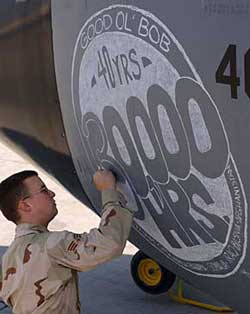
Senior Airman Jimmie Neel draws a tribute on "Bob" to highlight the aircraft's 30,000 flight-hour milestone the C-130 Hercules reached Jan. 26. Neel is a communication navigation journeyman assigned to the 778th Expeditionary Airlift Squadron Maintenance Flight at a forward-deployed location. He is deployed from Little Rock Air Force Base, Ark. (Photo by Senior Airman Joann Makinano)
"We do a job and that's to keep the aircraft flying," said Senior Airman Matt Kauffman, a 778th EAS dedicated crew chief. "The C-130 can do a variety of missions that no other aircraft can do and has proven repeatedly that it's the best."
Kauffman, who is deployed from the 463rd Aircraft Maintenance Squadron at Little Rock AFB, takes pride in his aircraft and being part of something that has been around longer than he has.
"To know what this aircraft has seen and done and made it through, it's an honor to be (working) on it," he said.
Bob made its first appearance during the Vietnam War, followed by missions in Grenada and Somalia. It also helped transport more than 189,000 tons of cargo during Operation Desert Storm. Its current mission has it ferrying troops and supplies into Afghanistan and throughout the U.S. Central Command area of responsibility. Besides OEF, it is also being used for Operation Southern Watch.
The C-130 has stood the test of time and is popular with the militaries of the world because it brings great versatility to the fight.
"The Herk's flexibility gives warfighting commanders unmatched capability to take the fight to the enemy, sustain our forces and return our troops to friendly lines when the mission is complete," said Lt. Col. C.K. Hyde, 320th Expeditionary Operations Group commander. "The Herk is a cornerstone of our current combat operations because it lives and works in the trenches; our troops are never alone when the C-130 is on duty."
First Lt. Mike Trodden, co-pilot deployed from Little Rock, said it is notable that during his first deployment, he is spending it on an aircraft that flew in Vietnam.
"It say's a lot about the durability of the aircraft," he said.
The crew members that flew Bob have shown durability themselves, having a combined total of approximately 30,000 flying hours. Johnston, deployed from the 317th Airlift Group at Dyess AFB, Texas, joined the Little Rock crew of Maj. Woody Ganis; Maj. Paul Cobb; Trodden; loadmasters Chief Master Sgt. Andre Greene, Senior Master Sgt. David Joslin and Tech. Sgt. Jimmie McKenzie; and Kauffman. All are assigned to the 778th EAS.
No one knows how many more flight hours Bob will accumulate, but the crew is keeping the faith.
"There isn't a maintainer in our squadron who will let an aircrew step onto an aircraft we wouldn't fly on ourselves," Kauffman said, "and I'm confident this aircraft will get me home every time."
100 Years After Kitty Hawk: Re-creation of Wright's First Flight
WARRENTON, Va., Jan. 29, 2003 -- The Discovery of Flight Foundation announced today a major gift from Northrop Grumman Corporation for pilot training as preparations continue for the Countdown to Kitty Hawk Celebration on Dec. 17, 2003. On that date, a pilot for The Wright Experience, which is under contract by the Foundation, will attempt to re-create Orville Wright's inaugural 120-feet flight in a precise reproduction of the original plane, 100 years later at the precise location of the original flight on the dunes of the Outer Banks in North Carolina.
The flight will be made in the authentic reproduction of the Wright brothers' original aircraft, the 1903 Wright Flyer. The aircraft is being built under the sponsorship of The Ford Motor Company and EAA. Ken Hyde, the founder of The Wright Experience, has been working for more than five years to research, redesign, remanufacture, test, analyze and document authentic Wright brothers' aircraft. He supervises a small army of engineers, mechanics and volunteers at his pristine shop near here between his home and a 2,100-foot grass landing strip. The gliders, powered flyers, original engines and propellers are made to exacting standards to ensure they share the precise characteristics of original Wright Brothers parts.
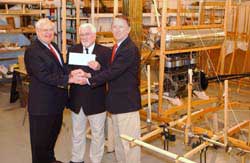
Weldon Britton, center, chairman of the Discovery of Flight Foundation, and Ken Hyde, founder, The Wright Experience, right, accept a contribution from Rich Milburn from Northrop Grumman Coporation. The contribution will be used for pilot training as the Foundation attempts to re-create Orville Wright's 120-foot flight in a precise reproduction of the original plane.
Weldon Britton, chairman of The Discovery of Flight Foundation and, along with Hyde, one of the charter members of this years-long endeavor, said the Northrop Grumman contribution will be key to the years of effort.
"The pilot training program is vital," Britton said. "Before that first flight 100 years ago, Orville and Wilbur Wright didn't know whether they would actually be able to fly their invention. We face many of their same risks, and this new gift will enable us to take some, but not all, of the risk out of the program."
Hyde and three other pilots picked for the training program have spent more than a year training on a glider, just as the Wright brothers did. Two of those four pilots will be selected to fly the '03 Flyer later this year, after wind tunnel testing on the aircraft has been completed, and after the training program has concluded. Scott Crossfield, a legendary aviation pioneer who was the first to fly at twice the speed of sound as a NASA test pilot, is in charge of the pilot training.
The glider being used as a trainer is also an exact reproduction of the Wrights that Hyde and his team of experts have constructed. Their reproductions are so precise that The Wright Experience is recognized by The Wright Family Foundation, descendants of the Wright Brothers who are involved in promoting the Wright brothers' aeronautical legacy. The Wright Experience was picked to attempt the 100th anniversary flight by the U. S. Park Service, which maintains the Kitty Hawk site.
Northrop Grumman's donation will fund the construction of the Wright Model B project, which they intend to fly and display for educational and promotional purposes throughout the country through 2008. Northrop Grumman's funding will also be a major part in a NOVA documentary, "Inventing the Flying Machine," that will air in October on public television. The Model B will also be on display as the centerpiece of Northrop Grumman Corporation's exhibit at the Paris Air Show this June.
"Northrop Grumman is proud to participate in this unique undertaking that will enable a reproduction of the original Wright Flyer to grace the skies," said Kent Kresa, Northrop Grumman chairman and chief executive officer. "The 100th anniversary of human flight reminds us of a seminal moment in aviation and American history. It is altogether fitting for Northrop Grumman, a company with an exceptional tradition of designing and building innovative aircraft, to contribute to this project."
The Discovery of Flight Foundation is a nonprofit organization which seeks to rediscover the Wright brothers' experimentation, discovery and methodology, provide for the reconstruction of original Wright Brothers aircraft and create a living classroom for people of all ages. The Wright Experience celebrates the achievements of Wilbur and Orville Wright by researching, reconstructing, testing, analyzing and documenting authentic full-scale reproductions of the Wright brothers' developmental aircraft and engines. For more information on both organizations, visit their websites: www.discoveryofflight.org or www.wrightexperience.com.
U.S. Navy Gets 167 New Tactical Tomahawks
TUCSON, Ariz. — The U.S. Navy awarded Raytheon Company a $224.5 million modification to a previously awarded fixed price incentive contract for the production of an additional 167 Tactical Tomahawk all-up round missiles. The majority of the work will be performed in Tucson. Work is scheduled to be complete by August 2005. "This award follows our highly successful contractor flight test program and a favorable operational assessment by the Navy," said Louise Francesconi, president, Raytheon Missile Systems, Tucson, Ariz. "Raytheon is pleased with this opportunity to provide our war fighters with this much needed next generation cruise missile capability."
Tomahawk, the surface- and submarine-launched, precision strike stand-off weapon, is the Navy's weapon of choice for critical, long-range precision strike missions against high value, heavily defended targets.
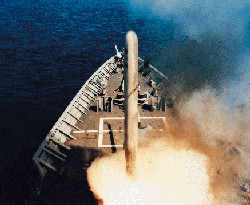
Tomahawk missile launches from U.S. Navy ship
"This award recognizes the successful partnership of Raytheon and the U.S. Navy as evidenced by the resounding success of the demonstration test phase of the Tactical Tomahawk program," said Captain Bob Novak, program manager for the Tomahawk All-Up-Round (PMA-280). "Tactical Tomahawk will provide transformational warfighting capabilities at a lower cost than a Block III Tomahawk."
Tactical Tomahawk will incorporate innovative technologies to provide new operational capabilities while dramatically reducing acquisition and life cycle costs. Scheduled for fleet introduction in 2004, the Tactical Tomahawk will cost less than half of a newly built Block III missile and will have the capability to respond to changing battlefield conditions through the use of its loiter and mission flex features.
Web site: Raytheon
| Send Us News | Archives | Main |